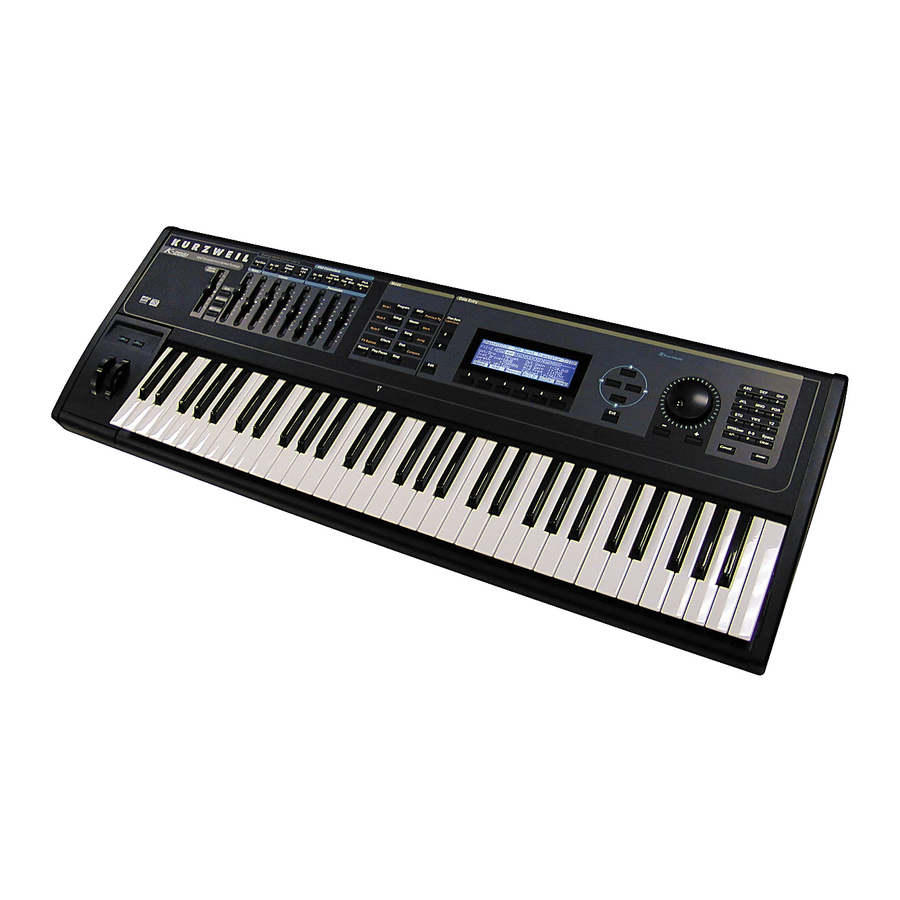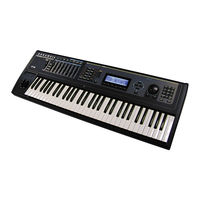
Kurzweil K2661 Manuals
Manuals and User Guides for Kurzweil K2661. We have 4 Kurzweil K2661 manuals available for free PDF download: Musician's Manual, Musician’s Reference Manual, Getting Started Manual, Install Manual
Kurzweil K2661 Musician's Manual (610 pages)
Kurzweil K2661: User Guide
Brand: Kurzweil
|
Category: Synthesizer
|
Size: 6 MB
Table of Contents
-
-
Welcome23
-
-
-
-
Programs32
-
Setups34
-
Quick Access35
-
-
-
Mode Buttons38
-
-
Navigation38
-
The Display38
-
Pages38
-
The Top Line39
-
-
Data Entry40
-
Search43
-
-
-
-
Program Mode49
-
Setup Mode49
-
Effects Mode50
-
MIDI Mode50
-
Master Mode50
-
Song Mode50
-
Disk Mode50
-
-
-
Background59
-
KB3 Mode62
-
-
-
Fine Hz85
-
-
-
Adjust86
-
Key Tracking86
-
Pad87
-
-
-
-
Monophonic91
-
Legato Play91
-
Portamento91
-
Globals92
-
Outpair93
-
-
Adjust98
-
Key Tracking98
-
Impact98
-
-
The LFO Page98
-
Minimum Rate99
-
Maximum Rate99
-
Rate Control99
-
LFO Shape99
-
LFO Phase100
-
-
The ASR Page100
-
The KDFX Page102
-
-
The TONEWL Page106
-
Upper/Lower Swap108
-
Wheel Volume Map108
-
Organ Map108
-
Lowest Pitch108
-
The DRAWBR Page109
-
The PITCH Page110
-
The PERC Page110
-
The PERC2 Page112
-
The KEYCLK Page112
-
Keyclick113
-
Volume113
-
Decay113
-
Pitch113
-
Veltrk113
-
Random113
-
Retrigthresh113
-
Note Attack114
-
Note Release114
-
-
The AMP Page114
-
The OUTPUT Page114
-
The MISC Page115
-
Preampresp115
-
Leakage115
-
Leakmode115
-
Speedctl116
-
Vibchorctl116
-
Vibchorsel116
-
Voladjust116
-
Bendrange116
-
Sustain116
-
Sostenuto116
-
-
The EQ Page117
-
Programming Tips117
-
-
-
Setup Mode121
-
The Setup Editor125
-
-
Channel126
-
MIDI Bank127
-
Status128
-
Destination129
-
MIDI Bank Mode129
-
The BEND Page138
-
Controllers139
-
-
Scale144
-
Offset (Add)144
-
Curve (Curv)144
-
The RIBBON Page147
-
The WHEEL Page149
-
-
Destination150
-
On Value151
-
Off Value151
-
The SWITCH Page152
-
The COMMON Page153
-
Song153
-
Song Control154
-
Sync154
-
Mutes154
-
-
-
Active156
-
Sync156
-
Latch157
-
Order158
-
Beats158
-
Tempo158
-
Note Shift158
-
Shift Limit158
-
Limit Option159
-
Glissando160
-
Velocity160
-
Duration160
-
-
-
-
Name163
-
Save163
-
Delete163
-
Dump164
-
New Zone (Newzn)164
-
Copy and Paste164
-
Clear165
-
-
-
-
Introduction169
-
Terminology170
-
Studio170
-
FX Preset171
-
Algorithm171
-
Size/Paus171
-
Parameters171
-
Fxmods172
-
Fxctrl172
-
Studio Editor172
-
-
MAIN Page173
-
The CTRL Page177
-
Studio179
-
Chaining Effects183
-
-
The Studio184
-
-
A Simple Studio189
-
Chaining Effects198
-
Advertisement
KURZWEIL K2661 Musician’s Reference Manual (501 pages)
Brand: KURZWEIL
|
Category: Electronic Keyboard
|
Size: 8 MB
Table of Contents
-
-
Soft Buttons10
-
Exit Button10
-
Alpha Wheel10
-
The Display11
-
Solo Button11
-
LFO Shapes15
-
-
-
-
-
-
-
Ground Hum76
-
Kurzweil K2661 Getting Started Manual (286 pages)
Toshiba Corporation Getting Started Guide stereo piano K2661
Brand: Kurzweil
|
Category: Synthesizer
|
Size: 2 MB
Table of Contents
-
-
Mode Buttons22
-
Navigation22
-
Disk Mode22
-
The Top Line23
-
-
Data Entry24
-
Search27
-
-
-
Effects Mode34
-
Master Mode34
-
MIDI Mode34
-
Song Mode34
-
Disk Mode34
-
-
-
Introduction59
-
Terminology60
-
MAIN Page63
-
-
-
-
Bend Smooth82
-
Bank Select83
-
Power Mode83
-
-
-
The Vocoder95
-
View Mode100
-
-
Object Utilities105
Advertisement
Kurzweil K2661 Install Manual (8 pages)
ROM Options
Brand: Kurzweil
|
Category: Electronic Keyboard
|
Size: 0 MB
Advertisement
Related Products
- Kurzweil K2600R
- Kurzweil K2600Rs
- Kurzweil K2600xs
- Kurzweil K2600 - MUSICIANS GUIDE REV A PART NUMBER 910330 CHAP 2
- Kurzweil K2600 - MUSICIANS GUIDE REV A PART NUMBER 910330 CHAP 7
- KURZWEIL K2600 - MUSICIANS GUIDE REV A PART NUMBER 910330 CHAP 15
- KURZWEIL K2600 V4 GM MODE - REV B
- Kurzweil K2600 AES
- KURZWEIL K2600 - MUSICIANS GUIDE REV A PART NUMBER 910330 CHAP 9
- KURZWEIL K2600 - MUSICIANS GUIDE REV A PART NUMBER 910330 CHAP 13



